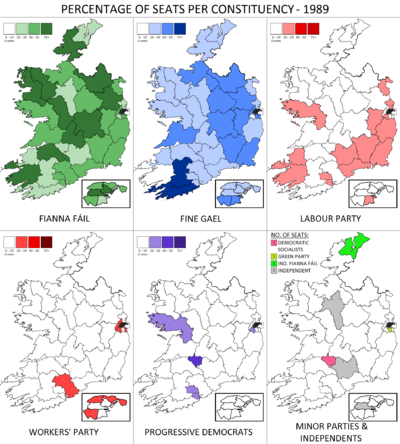Irish general election, 1989
|
|
|||||||||||||||||||||||||||||||||||||||||||||||||||||||||||||||||||||||||||||||||||||||||||||||||||||
|---|---|---|---|---|---|---|---|---|---|---|---|---|---|---|---|---|---|---|---|---|---|---|---|---|---|---|---|---|---|---|---|---|---|---|---|---|---|---|---|---|---|---|---|---|---|---|---|---|---|---|---|---|---|---|---|---|---|---|---|---|---|---|---|---|---|---|---|---|---|---|---|---|---|---|---|---|---|---|---|---|---|---|---|---|---|---|---|---|---|---|---|---|---|---|---|---|---|---|---|---|---|
|
|||||||||||||||||||||||||||||||||||||||||||||||||||||||||||||||||||||||||||||||||||||||||||||||||||||
|
|
|||||||||||||||||||||||||||||||||||||||||||||||||||||||||||||||||||||||||||||||||||||||||||||||||||||
|
165 of 166 seats in Dáil Éireann 84 seats were needed for a majority |
|||||||||||||||||||||||||||||||||||||||||||||||||||||||||||||||||||||||||||||||||||||||||||||||||||||
| Turnout | 68.5% | ||||||||||||||||||||||||||||||||||||||||||||||||||||||||||||||||||||||||||||||||||||||||||||||||||||
|
|||||||||||||||||||||||||||||||||||||||||||||||||||||||||||||||||||||||||||||||||||||||||||||||||||||

Percentage of seats gained by each of the three biggest parties, and number of seats gained by smaller parties and independents.
|
|||||||||||||||||||||||||||||||||||||||||||||||||||||||||||||||||||||||||||||||||||||||||||||||||||||
|
|||||||||||||||||||||||||||||||||||||||||||||||||||||||||||||||||||||||||||||||||||||||||||||||||||||
The Irish general election of 1989 was held on Thursday 15 June 1989, three weeks after the dissolution of the Dáil on 25 May. The newly elected 166 members of the 26th Dáil assembled at Leinster House on 29 June. However, a new Taoiseach and a Fianna Fáil-Progressive Democrats government were not appointed until 12 July.
The general election took place in 41 parliamentary constituencies throughout Ireland for 166 seats in the lower house of parliament, Dáil Éireann.
The general election of 1989 was precipitated by the defeat of the minority Fianna Fáil government in a private members motion regarding the provision of funds for AIDS sufferers. While a general election was not necessary – the defeat was seen merely as an embarrassment for the government – the Dáil was dissolved nonetheless.
Charles Haughey, the Fianna Fáil leader, called the general election for another reason; opinion polls had shown that the party's strong performance in government had increased their popularity and an overall majority for Fianna Fáil could be a possibility. Also, rumours were current that the general election was called so that certain Fianna Fáil members could raise money privately for themselves. While these rumours were dismissed at the time, it was revealed more than ten years later that Ray Burke, Pádraig Flynn and Haughey himself had received substantial personal donations during the campaign.
While it was thought that the general election would catch the opposition parties unprepared, they co-ordinated themselves and co-operated very quickly. Further cuts in spending, particularly in the health service, became the dominant issue. Alan Dukes was fighting his first (and as events would prove, his only) general election as leader of Fine Gael. His "Tallaght Strategy" had kept Fianna Fáil in power, governing as a minority, since 1987.
...
Wikipedia



